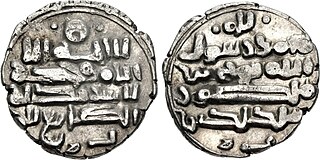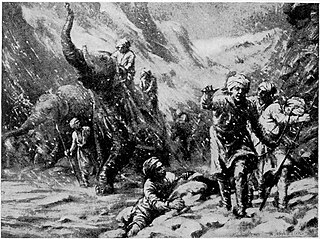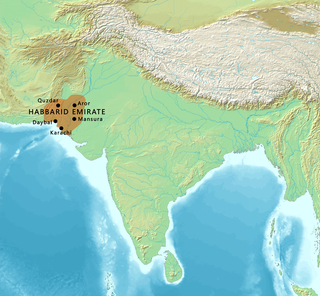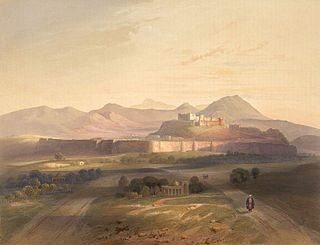Related Research Articles

The Muslim conquests of Afghanistan began during the Muslim conquest of Persia as the Arab Muslims migrated eastwards to Khorasan, Sistan and Transoxiana. Fifteen years after the battle of Nahāvand in 642 AD, they controlled all Sasanian domains except in Afghanistan. Fuller Islamization was not achieved until the period between 10th and 12th centuries under Ghaznavid and Ghurid dynasties who patronized Muslim religious institutions.

The Delhi Sultanate or the Sultanate of Delhi was a late medieval empire primarily based in Delhi that stretched over large parts of the Indian subcontinent, for 320 years (1206–1526). Following the invasion of South Asia by the Ghurid dynasty, five dynasties ruled over the Delhi Sultanate sequentially: the Mamluk dynasty (1206–1290), the Khalji dynasty (1290–1320), the Tughlaq dynasty (1320–1414), the Sayyid dynasty (1414–1451), and the Lodi dynasty (1451–1526). It covered large swaths of territory in modern-day India, Pakistan, and Bangladesh as well as some parts of southern Nepal.

Laghman is one of the 34 provinces of Afghanistan, located in the eastern part of the country. It has a population of about 502,148, which is multi-ethnic and mostly a rural society. Laghman hosts a large number of historical landmarks, minarets, monuments, and other cultural relics that are manifestation of its old history and culture. The city of Mihtarlam serves as the capital of the province. In some historical texts the name is written as "Lamghan" or as "Lamghanat".

The History of Punjab refers to the past history of Punjab region which is a geopolitical, cultural, and historical region in the northwest of South Asia, comprising eastern Punjab province in Pakistan and western Punjab state in India. It is believed that the earliest evidence of human habitation in Punjab traces to the Soan valley of the Pothohar, between the Indus and the Jhelum rivers, where Soanian culture developed between 774,000 BC and 11,700 BC. This period goes back to the first interglacial period in the second Ice Age, from which remnants of stone and flint tools have been found.

The Ghaznavid dynasty or the Ghaznavid Empire was a Persianate Muslim dynasty and empire of Turkic mamluk origin, ruling at its greatest extent from the Oxus to the Indus Valley from 977 to 1186. The dynasty was founded by Sabuktigin upon his succession to the rule of Ghazna after the death of his father-in-law, Alp Tigin, who was an ex-general of the Samanid Empire from Balkh.

Abu Mansur Nasir ad-Din wa'd-Dawla Sabuktigin was the founder of the Ghaznavid dynasty, and amir of Ghazna from 977 to 997. Sabuktigin was a Turkic slave who was bought by Alp-Tegin, the commander of the royal guard of the Samanid dynasty. Alp-Tegin established himself as the governor of Ghazna in 962, and died a year later in 963. Afterwards, Sabuktigin built his prestige among other slave soldiers in Ghazna until he was elected by them as their ruler in 977.

Abu al-Qasim Mahmud ibn Sabuktigin, usually known as Mahmud of Ghazni or Mahmud Ghaznavi, was Sultan of the Ghaznavid Empire, ruling from 998 to 1030. During his reign and in medieval sources, he is usually known by his honorific Yamin al-Dawla. At the time of his death, his kingdom had been transformed into an extensive military empire, which extended from northwestern Iran proper to the Punjab in the Indian subcontinent, Khwarazm in Transoxiana, and Makran.

Jayapala was a ruler of the Hindu Shahi dynasty from 964 to 1001 CE. He ruled over the area which stretched from Laghman in the west, to Kashmir in the east and from Sirhind to Multan. He was the son of Hutpal and the father of Anandapala. Epithets from the Bari Kot inscriptions record his full title as "Parama Bhattaraka Maharajadhiraja Sri Jayapaladeva".
The recorded history of Lahore, the second largest city-district of Pakistan, covers thousands of years. Lahore is regarded as the post medieval or modern day capital and largest city of the Punjab region, it has since its creation changed hands from Ghaznavid, Hindu, Buddhist, Greek, Muslim, Mughal, Ghorid, Maratha, Sikh and the British, thereby becoming the cultural capital and the heart of modern-day Pakistan.
Abu Ali Lawik of the Lawik dynasty was the son of Abu Bakr Lawik, and also a brother-in-law of the Hindu Shahi ruler of the region, Kabul Shah. He was invited by the people of Ghazni to overthrow Böritigin or Pirai and proceeded in alliance with the Shahi Rulers of the region in this venture.
'Yamini Turks had claimed their descent from Shahyar, the last of the Parthian ruler who was killed in 637AD in the battle of Cadesia. The family had migrated to Turkistan and after three generations had passed on as Turks. Their founder Sabuktgin had come into the service of Alptgin, a Samanid governor of Turkistan. The latter had captured Ghazni and settled there in 963AD. He raised Sabuktigin to the position of a general. After the death of Alptgin in 966 AD, Balktgin the commander of Turkish troops succeeded him who was later succeeded by Pirai a slave. The latter was a cruel king and the people of Zabul invited Abu Ali Lawik son of the last ruler of Zabul who in alliance with the Shahis of Udabhanda marched to recover Ghazni. On the way at Charkh, Sabuktgin defeated them and became a hero.
Multan in Punjab province of Pakistan is one of the oldest cities of South Asia, though its exact age has yet to be determined. Multan is known for its rich ancient heritage and historic landmarks. Multan was the capital and largest city of Punjab region in late ancient and most of the medieval era. Multan region was centre of many civilizations in its 5 millenia old history, and witnessed warfare across millennia because of its location on a major invasion route between South and Central Asia.

The Habbari were an Arab dynasty that ruled much of Greater Sindh, as a semi-independent emirate from 854 to 1024. Beginning with the rule of 'Umar bin Abdul Aziz al-Habbari in 854 CE, the region became semi-independent from the Abbasid Caliphate in 861, while continuing to nominally pledge allegiance to the Abbasid Caliph in Baghdad. The Habbari ascension marked the end of a period of direct rule of Sindh by the Umayyad and Abbasid Caliphates, which had begun in 711 CE.
The Hindu Shahis also referred to as the Uḍi Śāhis were a dynasty established between 843 CE and 1026 CE. They endured multiple waves of conquests for nearly two centuries and their core territory was described as having contained the regions of Eastern Afghanistan and Gandhara, encompassing the area up to the Sutlej river in modern day Punjab, expanding into the Kangra Valley. The empire was founded by Kallar in c. 843 CE after overthrowing Lagaturman, the last Turk Shahi king.
The Lodi dynasty was the last dynasty to rule over Emirate of Multan, from their capital city of Multan in the 10th century.

The Lawīk dynasty was the last native dynasty which ruled Ghazni prior to the Ghaznavid conquest in the present-day Afghanistan. Lawiks were originally Hindus, but later became Muslims. They were closely related to the Hindu Shahis, and after 877, ruled under the Hindu Shahi suzerainty.

Emirate of Multan was a medieval Muslim emirate in Punjab that was centred around city of Multan, present-day part of Punjab, Pakistan. It was initially ruled by the tribe of Banu Munabbih. In 959 CE, Ismaili Qarmatians under Banu Lawi gained control of the Emirate and in 1010, it was conquered by Ghaznavid Empire.

The Second Battle of Laghman was fought between the Ghaznavid forces under Sabuktigin and the Hindu Shahi under Jayapala near Laghman in 991 AD. It took place near Laghman, present day Afghanistan.

The First Battle of Laghman was fought near Laghman in present-day Afghanistan, between the Ghaznavid empire under Sabuktigin and the Hindu Shahis under Jayapala in 988 CE. The Ghaznavids defeated the Hindu Shahis and Jayapala signed a treaty in which the Hindu Shahis paid tribute to Ghaznavids.

The Ghaznavid campaigns in India refer to a series of military expeditions lasting 54 years (973–1027) launched by the Ghaznavid Empire, a prominent empire of the 10th and 11th centuries, into the Indian subcontinent, led primarily by Sultan Mahmud of Ghazni, leaving a profound impact on the region's history and culture.
References
- ↑ MacLean, Derryl N. (20 October 2023). Religion and Society in Arab Sind. BRILL. p. 533. ISBN 978-90-04-66929-1.
- ↑ Seyfeydinovich, Asimov, Muhammad; Edmund, Bosworth, Clifford; UNESCO (31 December 1998). History of civilizations of Central Asia: The Age of Achievement: A.D. 750 to the End of the Fifteenth Century. UNESCO Publishing. p. 302-303. ISBN 978-92-3-103467-1.
{{cite book}}: CS1 maint: multiple names: authors list (link) - ↑ "Lōdīs". referenceworks. Retrieved 22 May 2024.
"The Lōdīs are related to a clan of the Ghilzay tribe of Afghanistān [see ghalzay] and ruled over parts of north India for 77 years. Afghāns came to the Indus plains from Rōh [q.v.] as early as 934/711-12 with the army of Muḥammad b. Ķāsim, the conqueror of Sind, and allied themselves politically with the Hindū-Shāhī [q.v.] rulers of Lahore, and receiving part of Lāmghān [see lāmghānāt ] for settlement, built a fort in the mountains of Peshawar to protect ¶ the Pandjāb from raids. During Alptigin's government at Ghazna, when his commander-in-chief Sebüktigin raided Lāmghān and Multān, the Afghans sought help from Rādjā Djaypāl who appointed their chief, Shaykh Ḥamīd Lōdī, viceroy of the wilāyats of Lamghān and Multān. Shaykh Ḥamīd appointed his own men as governors of those districts, and thereby the Afghāns gained political importance; their settlements stretched southwards from Lāmghān to Multān, incorporating the tracts of Bannū and Dērā Ismā'īl Khān. Later, a family of the Lōdī tribe settled at Multān, which was ruled in 396/1005 by Abu 'l-Fatḥ Dāwūd, a grandson of Shaykh Ḥamīd.
- ↑ Lal, Kishori Saran (1969). Studies in Asian History: Proceedings of the Asian History Congress, 1961. [Published for the] Indian Council for Cultural Relations [by] Asia Publishing House. ISBN 978-0-210-22748-0.
- ↑ Ahmad, Zulfiqar (1988). Notes on Punjab and Mughal India: Selections from Journal of the Punjab Historical Society. Sang-e-Meel Publications. p. 533.
- ↑ Samuel Miklos Stern (October 1949). "Ismā'ili Rule and Propaganda in Sīnd". Islamic Culture. 23. Islamic Culture Board: 303.
- ↑ Yogendra Mishra (1972). The Hindu Sahis of Afghanistan and the Punjab, A.D. 865-1026: A Phase of Islamic Advance Into India. Vaishali Bhavan. pp. 100–103.
- ↑ N. A. Baloch; A. Q. Rafiqi (1998). "The regions of Sind, Baluchistan, Multan and Kashmir". History of Civilizations of Central Asia, Volume 4. UNESCO. pp. 297–298. ISBN 9789231034671.